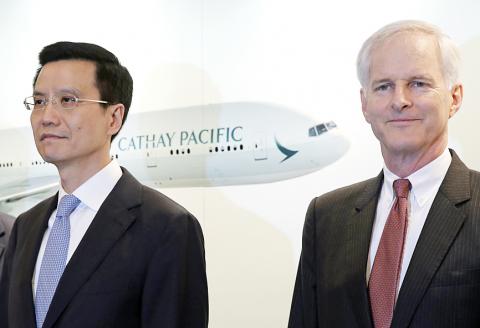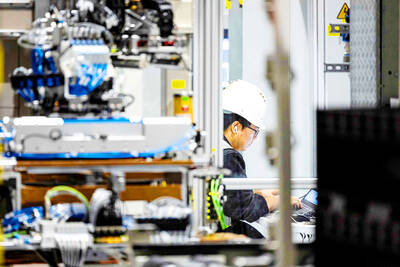Hong Kong’s troubled flagship airline Cathay Pacific yesterday posted its first annual loss since the height of the financial crisis as it was hit by “intense competition” and a drop in demand from business travelers.
The firm is struggling despite an expansion of international air travel in the region as lower cost carriers, particularly from China, eat into its market share.
Companies such as China Eastern Airlines Corp (中國東方航空) and China Southern Airlines (中國南方航空) are offering direct services to Europe and the US from China, while budget carriers like Spring Airlines (春秋航空) offer regional routes, undermining Cathay’s once critical Hong Kong hub.

Photo: AP
The airline is also losing premium travelers as it comes under pressure from Middle East rivals, which are expanding into Asia and offering more luxury touches.
Analysts said other established Asian operators were similarly suffering from increased competition, but believed Cathay’s major fuel-hedging losses put it in an even weaker position.
Its US$74 million net loss last year reversed a US$773 million profit in the previous year and comes as the firm prepares a wholesale review of its operations, with chairman John Slosar saying that this year would be similarly “challenging.”
The results, the worst since 2008, were also well off expectations, with an average profit of US$57.9 million forecast by analysts in a Bloomberg News survey. The company’s shares were down almost 5 percent in early afternoon trade.
Cathay announced a major restructuring program in January that it said would see jobs axed, but it has not said how many.
“Our organization will become leaner,” Slosar yesterday said in a statement to the Hong Kong Stock Exchange. “Our aim is to reduce our unit costs excluding fuel over the next three years.”
Passenger revenue dropped 8.4 percent year-on-year to $US8.6 billion, hit by overcapacity in the market and weak foreign currencies.
Analyst Jackson Wong (黃志陽) of Huarong International Securities (華融國際金融) said Cathay had lost its niche and would find it hard to turn the corner.
“For a big company like this, with competition in the market now, it’s extremely difficult to turn around the business,” he said.
Wong said cost-cutting was the path back to profitability but believed the firm needed to be clearer about what its restructuring would entail to win back investor confidence.
Cathay said it had benefited from low oil prices — fuel accounts for a huge portion of a carrier’s costs — but that advantage was reduced by US$1.1 billion in hedging losses.
Those losses were “largely incurred on hedges put in place when the fuel price was much higher than today” Slosar said.
Oil hedging is when an airline locks in prices of fuel at a pre-determined level for a certain amount of time.
The group’s cargo revenue last year also fell 13.2 percent on-year to US$2.6 billion.
International travel in the Asia-Pacific region last year grew 8.3 percent, according to the International Air Transport Association.
It beat global growth figures of 6.3 percent and was only behind the Middle East in the regional rankings.
However, high-profile carriers have nonetheless felt the pinch. Singapore Airlines saw net profit drop 35.6 percent year-on-year to US$125 million in the third quarter, it announced last month.
Japan Airlines reported its net profit was down 24.6 percent at US$955 million in the first nine months of last year compared with the same period the year before.

CHIP RACE: Three years of overbroad export controls drove foreign competitors to pursue their own AI chips, and ‘cost US taxpayers billions of dollars,’ Nvidia said China has figured out the US strategy for allowing it to buy Nvidia Corp’s H200s and is rejecting the artificial intelligence (AI) chip in favor of domestically developed semiconductors, White House AI adviser David Sacks said, citing news reports. US President Donald Trump on Monday said that he would allow shipments of Nvidia’s H200 chips to China, part of an administration effort backed by Sacks to challenge Chinese tech champions such as Huawei Technologies Co (華為) by bringing US competition to their home market. On Friday, Sacks signaled that he was uncertain about whether that approach would work. “They’re rejecting our chips,” Sacks

NATIONAL SECURITY: Intel’s testing of ACM tools despite US government control ‘highlights egregious gaps in US technology protection policies,’ a former official said Chipmaker Intel Corp has tested chipmaking tools this year from a toolmaker with deep roots in China and two overseas units that were targeted by US sanctions, according to two sources with direct knowledge of the matter. Intel, which fended off calls for its CEO’s resignation from US President Donald Trump in August over his alleged ties to China, got the tools from ACM Research Inc, a Fremont, California-based producer of chipmaking equipment. Two of ACM’s units, based in Shanghai and South Korea, were among a number of firms barred last year from receiving US technology over claims they have

It is challenging to build infrastructure in much of Europe. Constrained budgets and polarized politics tend to undermine long-term projects, forcing officials to react to emergencies rather than plan for the future. Not in Austria. Today, the country is to officially open its Koralmbahn tunnel, the 5.9 billion euro (US$6.9 billion) centerpiece of a groundbreaking new railway that will eventually run from Poland’s Baltic coast to the Adriatic Sea, transforming travel within Austria and positioning the Alpine nation at the forefront of logistics in Europe. “It is Austria’s biggest socio-economic experiment in over a century,” said Eric Kirschner, an economist at Graz-based Joanneum

France is developing domestic production of electric vehicle (EV) batteries with an eye on industrial independence, but Asian experts are proving key in launching operations. In the Verkor factory outside the northern city of Dunkirk, which was inaugurated on Thursday, foreign specialists, notably from South Korea and Malaysia, are training the local staff. Verkor is the third battery gigafactory to open in northern France in a region that has become known as “Battery Valley.” At the Automotive Energy Supply Corp (AESC) factory near the city of Douai, where production has been under way for several months, Chinese engineers and technicians supervise French recruits. “They